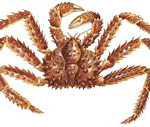
Homarus gammarus
Lobsters, like shrimps and crabs, are decapods – literally meaning 10 legs – and can be found in all of the world’s tropical and sub-tropical seas as well as more temperate waters. They are predatory, nocturnal animals with a vividly decorated coat. They are often numerous locally; they linger in crevices (with their long antennae sticking out) during the day and hunt small benthic organisms at night, but they also feed on organic detritus whenever they happen across it. As with all crustaceans, the lobster moults or sheds its shell to grow.
Up until the end of the 19th century lobster was so plentiful that it was often used as fish bait. Sadly, with lobster’s ever-increasing popularity those days are now gone forever. Lobsters have recently suffered a dramatic demographic decline; intensive fishing has annihilated entire populations, especially where tourism abounds.
The lobster families that are typically encountered by divers in many underwater locations around the world are the spiny rock lobsters, Palinuridae, the slipper lobsters, Scyllaridae and the true reef lobsters, Nephropidae.
The spiny lobsters rock lobsters,lack the enlarged claws of the true lobsters. Various species of spiny lobsters occur around the world; the most common genus is Panulirus. Commercial catches originate largely in the waters off South Africa and Namibia, Australia, New Zealand, France, Japan, Brazil, Cuba, the U.S., Mexico, and the Bahamas.
There are three species of true lobsters: the American lobster (Homarus americanus), the European lobster (Homarus gammarus), and theNorwegian lobster (Nephrops norvegicus). The American, also called Maine or northern lobster, occurs only off the eastern coast of North America, from Labrador to North
Carolina, but is so closely related to the European lobster, that geography is the primary differentiating characteristic. Both the European and Norwegian lobsters can be found in this eco-region. We are particularly interested in recording sightings of the European lobster.
European lobsters, like their American cousins, are unmistakable with their massive, almost bulbous pair of chelapeds (claws) and deep blue carapace, whereas the chelapeds of the Norwegian lobster are relatively longer and thinner. In the true lobsters, these chelapeds are unequal in size, one being used for crushing, one cutting.
The European lobster is omnivorous with a diet consisting of benthic (bottom dwelling) invertebrates, crabs, sea urchins, mussels, marine worms, periwinkles and sea stars. Fish and plants also contribute to the diet. Whilst the largest recorded catch of a European lobster is 1.26m, sizes that will typically be seen of mature lobsters will be 30-50cm.
These lobsters will avoid light, and are found on rocky substrata, living in holes and excavated tunnels from the lower shore to depths of 60m, using their compound eyes (at the end of moveable stalks) to detect movement.
The Norwegian lobster, also known as the Dublin Bay prawn, is a small lobster, pale orange in colour. It grows to a maximum total length of 24 cm, although is normally between 18-20cm.









Social Profiles